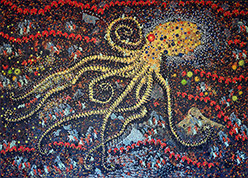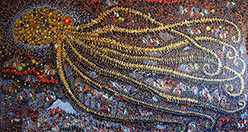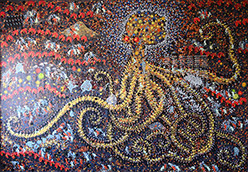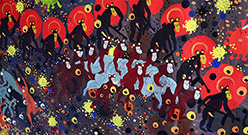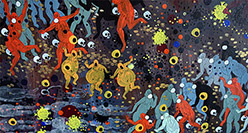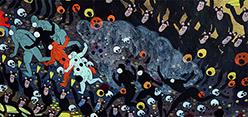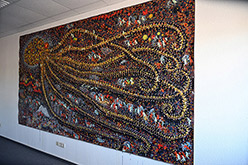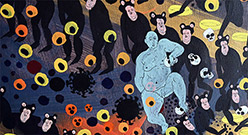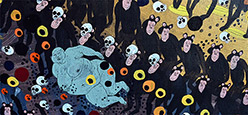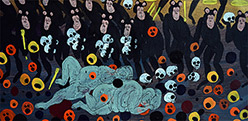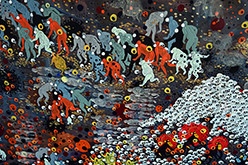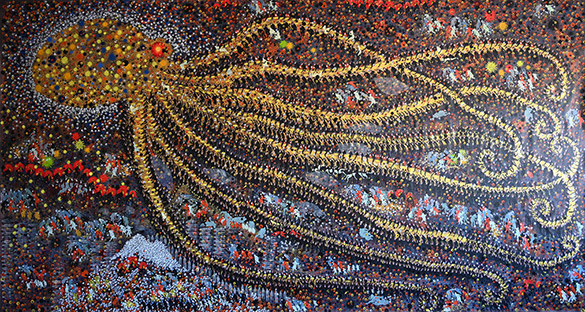
Maryna Magnin
Savoie, France – Octobre
2022
OtGO:
Triptych
The
Last Supper
-- The original text in French --
-- The text in German --
Translated by Caroline Girod. The English translation made public on 10 february 2023 Sliema, Malta
If there is, in my humble opinion, one word that could describe the work of the artist OtGO, it would be the word magician. He has indeed the incredible ability to bring his paintings to life. He gives them birth by creating them and then lets them grow and intensify under the eyes of those who contemplate them. Little by little, they become alive and animated. They come out of their frame, spill out and invade the room, leaving behind them a perfume that is at once sweet, bitter, and enigmatic. The Triptych: The Last Supper is a perfect example.
To begin with, one has to look at the paintings from afar while getting immersed in them. Soon, we will have the impression of attending a wild party or a particularly colorful carnival. The giant octopus, as if animated by a great number of dancers, moves slowly, with grace and lightness. If one listens carefully and dives into this universe, it becomes possible to hear music: some jazz, some piano notes, but also percussion sounds. Then, whistling, laughter of children and passers-by, and finally applause reach our ears. Everyone is drawn into an intoxicating waltz, without beginning or end. Only joy and intoxication remain. Warm colors like yellow and red contrast with white, blue, and black shades. They jump to our eyes and cling to our stunned faces. And here we are, charmed, drawn into this sweet atmosphere of celebration and happiness, our hearts beating. Soon the heat becomes noticeable, but it does not matter because the ambience is great.
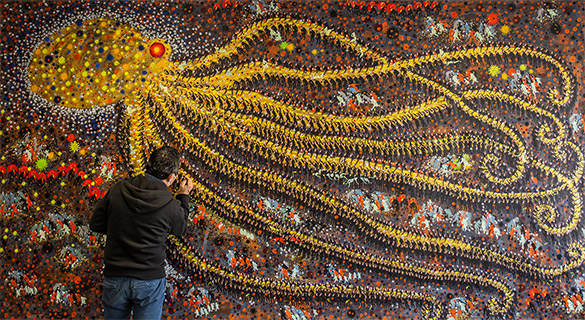
Triptych: The Last Supper by OtGO | Inside the Studio: Work in Progress | Photo by Anna Wyszomierska
However, getting closer to the painting and connecting our little grey cells, as a certain Hercule Poirot would say, is enough for the mask to fall and the reality to be revealed. The puzzle then begins to fall into place, a much darker and much less cheerful puzzle. Then, the music changes its tonality, and something gently breaks in our hearts, like glass cracking. Impossible to put it back together. We understand that we should look past appearances, and that we will have to dive deeper into these paintings to discover the truth. The details spurt out of every corner of the paintings, forcing us to a long contemplation to find the answers to our questions.The sounds of drums and piano are quickly replaced by the sound of flames. Laughter and applause are replaced by moans, cries, and pleas. The scene changes completely: we are no longer attending a party or a colorful carnival. After a few minutes of contemplation, we have gone from heaven to hell. The atmosphere becomes suffocating, and our panicked eyes fight tirelessly to find positivity, cheerfulness, and happiness. The blood-red eyes of the octopus cut off sharply this attempt, most probably doomed to failure. This creature stretches out and takes a central place in all three canvases. In The Last Supper 3, the creature resembles a bloodthirsty monster or some Terminator, lifeless and merciless, with only one goal: to crush and kill. Therefore, the humans’ tears and lamentations do not worry him at all, and his powerful tentacles are ready to seize his prey. This octopus becomes the ideal symbol to paint the virus that has fallen upon us and its many consequences.
For some, the octopus is the embodiment of hellish spirits, if not hell itself. Just like the virus, the octopus is silent, whatever the circumstances. It is the very example of adaptation and its ability to go unnoticed is extraordinary. This dazzling adaptation to its environment often involves mimicry and transformation. Like a magician, the octopus changes color according to its moods or needs by blending into the scenery, or goes even one step further by changing its shape. Moreover, its body being devoid of skeleton, it is very flexible. From the human point of view, these abilities impress and terrify. It is therefore not surprising that exactly this creature was chosen to embody both the monstrous Kraken, the concrete form of absolute evil hidden at the bottom of the waters, and the virus in OtGO’s paintings. Invisible and highly contagious, the latter plunged the entire planet into chaos, isolation, and grief. Like the octopus, the virus has adapted, giving rise to variants that continue to appear even today. It has no smell, no color and above all no face. And what cannot be seen has always been feared. The unknown, whether positive or negative, is terrifying. We have no weapons, no instructions to help us. We have to get out of our comfort zone, learn again how to live, and sometimes even how to survive by adapting to our new environment.
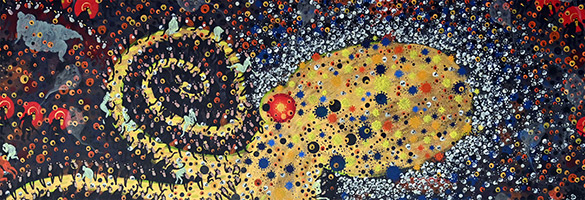
Detailed view: The Last Supper
To
emphasize the symbolic of disease, the cephalopod’s head is filled with
human skulls and viral particles. The latter are escaping, huge or in a
fine rain, until invading the whole canvas. After all, these small
stains that looked from afar like colorful lights or joyful confetti,
are in fact the representatives of this silent death. Observed from afar, the head of the octopus itself becomes a gigantic
human skull. This element is not so surprising after all, since it is
mankind who has created or at least actively participated in the
creation of this chaos.
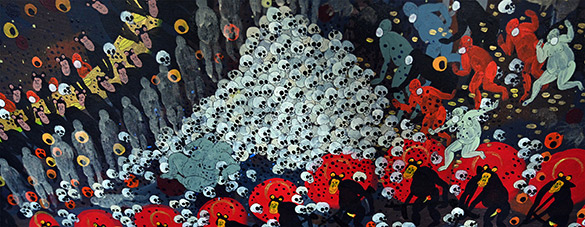
Detailed view: The Last Supper
Human
skulls are everywhere. They lie on the ground, in piles or scattered,
sad representatives of a human life that is running out of breath. The
survivors, forced to wander in the dark, understand only too well the
fate that awaits them. Gathered together, the skulls remind us of
ancient times when, in order to preserve those still alive, the bodies
contaminated by the plague or cholera epidemic were piled up and then
burned or quickly buried. As we continue our meticulous work of observation, the paintings reveal
to our eyes the presence of human souls. These souls, forced to leave
their bodies and their earthly existence, sadly look back at their
remains before slowly making their way to nothingness.

Detailed view: The Last Supper
The
epidemic has snatched them from life without warning like lightning in
the middle of a clear and peaceful day. They no longer have faces, nor
bodies, nor names. As Ernest Hemingway rightly said, "We must get used
to it: at the most important crossroads of our lives, there are no
signs". Only their silhouettes, almost transparent, remain for a while.
Are they Men or Women? One could not say it. In the face of
nothingness, nothing of all this subsists.

Detailed view: The Last Supper
The few humans still alive are not in any more luck. Some of them are nonetheless trying to flee while protecting their bodies with their hands. A mother, her child in her arms, is fighting to survive. Other women, who appear to be pregnant, are trying to save the life that is growing inside them. Unfortunately, despite the felt discomfort, despite the complaints of the tortured, we cannot save them. Only our eyes can brush them. The presence of orange brushstrokes on the black background of the canvases sends us back to the flames and the extreme heat. Very quickly, the feeling of being in an oven or a fireplace settles in us. No exit door on the horizon, not the slightest escape either.
Yet, among the human beings in the paintings, some seem to suffer less than others. Much taller and heavier, in an almost supernatural way, they don't seem to care about what is happening around them. Sitting, lying or almost gravitating, their look expresses complete indifference, if not even contempt towards the fate reserved to their peers who are shouting, agitating, and finally dying. Their chubby bodies, sometimes pushed to an extreme obesity, refer to the series of paintings of Lucian Freud and resound as a tribute to the work of the artist. Incidentally, the pose of certain characters is easily recognizable and refers directly to the paintings of Freud: "Naked man, back view" (1991-1992), "Naked portrait with reflection" (1980) or "Benefits Supervisor Sleeping II" (1995). The bodies of these people represent greed, cupidity, the thirst for power and money. They need more, always more, because only that counts, only that obsesses them. Hence the fact that they seem elsewhere, completely out of this world. Even though they are alive, their humanity is lost. They are nothing more than empty shells, insensitive and isolated beings.

Detailed view: The Last Supper

Detailed view: The Last Supper
By dint of excess, the human race has pushed its own existence to destruction and suffering. This can be seen very clearly in OtGO's paintings. Only the humans are suffering from the situation. The monkeys are feasting. The presence of forks, plates and champagne flutes clearly indicates that this situation, terrible for mankind, is a real blessing for the animals. The octopus's tentacles become tables, and nothing disturbs their good mood. They are raising their glasses, as if toasting, while taunting the frightened and weakened humans. The contrast created by OtGO between the two situations is striking and pushes the spectators that we are to look reality in the face. We then become witnesses of our collective suicide, for our eyes have brushed the canvases. Some bipeds, crowned like kings, seem to lead this little party. When some see their cup rising, others see their head falling.

Detailed view: The Last Supper
More cruel than the party primates, huge gorillas make this scene even more violent by transforming it into a place of war and desolation: larger than the others, with oversized genitals and rifles in their hands, they are scrutinizing the few humans still alive. The appearance of the latter, completely naked and left to their fate, reminds us of the horrors that humanity has inflicted on itself and on animal life throughout History. Painted on a red background, halo above their heads, the torturers seem to put on suits of sanctity while punishing criminal souls. Just like in Pierre de Marivaux's Slave Island (L'île des Esclaves), the masters have become the slaves and the slaves, the new masters. But unlike Marivaux's book, no forgiveness is possible. Impulses and violence have prevailed over reason and mercy.

Detailed view:The Last Supper
Another important element present in the paintings: money. Usually so precious to humans, it is here amassed in huge piles just like the skulls and practically forgotten. It is of no use here and is abandoned, like a futile piece of plastic. This money, made by men, for men, cannot save them from an invisible and silent threat. Illustrating to perfection the decay of the consumer society that glorifies and elevates all that glitters, money reveals here its dark side and appears shamefully inefficient. In the deepest chaos, when the survival of humanity is at stake, it becomes derisory again. Its preciousness is known only to men. Just like banknotes, reduced to their original state of paper during major stock market crashes, gold coins are reduced to the state of metal. Out of revenge or perhaps mockery, little red monkeys are having fun throwing survivors into the gold pile, thus giving them a bitter lesson. Like Midas, condemned to see everything he touches turn into gold, the men are drowned in this gold for which they once were ready to make any sacrifice.
Looking at the three paintings one after the other, a new impression can arise: that of having before one’s eyes a single canvas, painted in profile and then in front. The octopuses, in the center of the three paintings, become then one and the same creature, although the shape of the tentacles changes between the paintings. This can be explained by the fact that OtGO's artwork often represents the idea of movement. To realize this titanic work, requiring extreme meticulousness, OtGO used the same techniques as for the realization of Thangkas, these small colored paintings representing several deities or Buddhas. This work, similar to a meditation, requires a great concentration and a complete letting go of what is happening in the outside world.
In the end, this Triptych is aptly named. This dinner may be the last one, as much for the human race as for the apes sitting at the table, they who are the symbols of the origin of humans on Earth. In a world that pretends to be more and more controlled, the episode of the Corona virus reveals to us that we are the masters only of our hearts. There lies our heritage and the object of our salvation. Nature alarms us, but we remain silent, blind, mute. After all, it is impossible to wake up someone who is pretending to sleep. But who knows, hope springs eternal.

